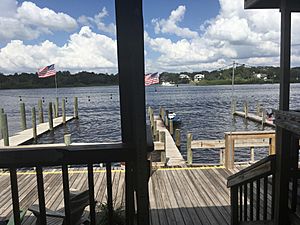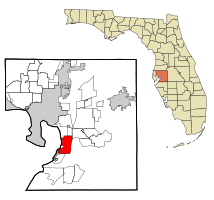Gibsonton, Florida facts for kids
Quick facts for kids
Gibsonton, Florida
|
|
|---|---|

View of a river in Gibsonton
|
|

Location in Hillsborough County and the U.S. state of Florida
|
|
| Country | |
| State | |
| County | |
| Area | |
| • Total | 15.44 sq mi (40.00 km2) |
| • Land | 12.81 sq mi (33.19 km2) |
| • Water | 2.63 sq mi (6.81 km2) |
| Elevation | 7 ft (2 m) |
| Population
(2020)
|
|
| • Total | 18,566 |
| • Density | 1,448.88/sq mi (559.42/km2) |
| Time zone | UTC-5 (Eastern (EST)) |
| • Summer (DST) | UTC-4 (EDT) |
| ZIP code |
33534
|
| Area code(s) | 813 |
| FIPS code | 12-25900 |
| GNIS feature ID | 0283060 |
Gibsonton, also called Gibtown, is a special place in Hillsborough County, Florida, United States. It's known as a "census-designated place," which means it's a community that isn't officially a city but has its own identity. About 18,566 people lived here in 2020.
Gibsonton became famous as a winter home for people who worked in circuses and carnivals. When the traveling shows closed for the colder months, many performers and workers would come to Gibsonton. This was handy because other big circuses, like Ringling Brothers, had winter homes nearby in Florida.
This town was once home to unique performers like Percilla the Monkey Girl and the "Lobster Boy." Even Siamese twin sisters ran a fruit stand here! Gibsonton was so special that its post office even had a low counter for people with dwarfism. What made Gibsonton truly unique were its local laws. These laws allowed circus folk to keep large animals like elephants and their big circus trailers right on their front lawns!
The town was founded in 1884 by James Gibson Sr. He settled on 150 acres of land near the Alafia River. Gibson also helped start a school in the area in 1888.
Contents
Exploring Gibsonton's Location
Gibsonton is located in the southern part of Hillsborough County. It sits near Hillsborough Bay to the west. To the north and east, you'll find Riverview, and to the south is Apollo Beach.
U.S. Route 41 goes right through the middle of Gibsonton. This road can take you north about 7 miles to Tampa or south about 30 miles to Bradenton. Another major road, Interstate 75, runs through the eastern side of Gibsonton. You can get on I-75 from Exits 246 and 250. This interstate goes north to the Brandon area and south to Bradenton.
The total area of Gibsonton is about 15.44 square miles (40.0 square kilometers). Most of this area is land, but about 2.63 square miles (6.8 square kilometers) is water.
Who Lives in Gibsonton?
| Historical population | |||
|---|---|---|---|
| Census | Pop. | %± | |
| 1990 | 7,706 | — | |
| 2000 | 8,752 | 13.6% | |
| 2010 | 14,234 | 62.6% | |
| 2020 | 18,566 | 30.4% | |
| source: | |||
In 2010, there were 14,234 people living in Gibsonton. The population grew to 18,566 by 2020.
Here's a look at the people living in Gibsonton in 2010:
- About 72.8% were White.
- About 12.7% were African American.
- About 27.9% of the population were Hispanic or Latino.
Many families live in Gibsonton. In 2010, about 36.7% of homes had children under 18 living there. The average household had about 2.8 people. The median age of people in Gibsonton was 32 years old. This means half the people were younger than 32, and half were older.
The Showmen's Association and Museum
Gibsonton is home to the International Independent Showmen's Association, often called the Gibtown Showmen's Club. This is a special group for people who work in the outdoor amusement industry, like carnivals and circuses. It's a non-profit organization that started in 1966. It's now the largest showmen's association in the United States, with over 4,500 members from many different countries.
Gibsonton also hosts the biggest trade show for the carnival industry. At this show, you can see all sorts of things related to carnivals. This includes rides, food equipment, concession trailers, and even novelty items like plush toys.
The Showmen's Museum
The International Independent Showmen's Museum in Gibtown tells the story of the carnival. It has two floors filled with old equipment, historical papers, and detailed displays. Most of these items were given by real "carnies" (people who work in carnivals). The museum has items from all over the country, showing almost 100 years of carnival history.
Inside the museum, you can see:
- Photos of how carnivals were set up over the years.
- A focus on how carnivals moved from place to place.
- One of the very first Ferris wheels in the U.S., assembled right in the middle of the museum.
- Costumes, like one worn by famous dancer Gypsy Rose Lee and another by the Viking Giant Jóhann K. Pétursson.
- Carnival trailers that open up to show bright, fancy insides.
Connecting with the Library
The library at the University of South Florida (USF) has made many photos from the International Independent Showmen's Museum available online. These photos show what life was like in American carnivals from the late 1800s until today. They especially highlight how carnivals used semi-trailers and trains to travel.
You can see these photos online through the USF website. The actual collection of photos is kept at the museum. Many people from the Showmen's Association helped make this digital collection possible.
The USF Library also has a collection of "oral histories" from showmen. An oral history is when someone records and saves stories told by people. These stories are important because they capture memories from a specific time, helping us understand cultural heritage.
Famous People from Gibsonton
- Grady Stiles: A performer known as "Lobster Boy."
- Al Tomaini: Once known as the world's tallest man.
Gibsonton in Pop Culture
Gibsonton has appeared in many TV shows, books, and songs:
- The 1995 TV show X-Files had an episode called "Humbug" set in Gibsonton. It was about sideshow performers.
- The book Twilight Eyes by Dean Koontz features a character who finds safety in the circus community of "Gibtown."
- A song called "Gibsonton" was released in 1992 by The Babylon Minstrels.
- The novel Kaleidoscope by Darrell Wimberly is inspired by Gibsonton.
- The TV show The Glades had an episode in 2011 called "Gibtown." It was about a murder in a town known for retired circus performers.
- In the novel Once Burned by Jeaniene Frost, the main character Leila is from Gibsonton. She can channel electricity and learn secrets by touch.
- Kevin Smith visited Gibsonton for a segment on The Tonight Show.
- Josh Reilly has a song about Gibsonton on his album "Mercy On The Strange."
- The TV show Bar Rescue filmed episodes in Gibsonton, including one where Jon Taffer helped a bar on the Alafia River.
See also
 In Spanish: Gibsonton para niños
In Spanish: Gibsonton para niños

